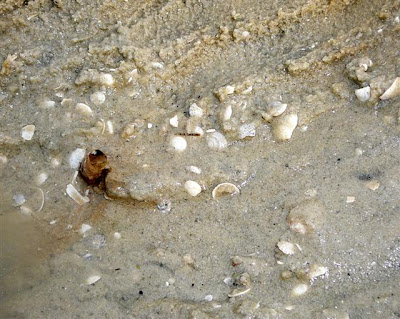
As I entered the entrance of the sand bar, the first thing that caught my attention was the increase in the density and number of tubeworms. I remember the sand bar was quite barren last year.

Immediately, I went to check the anemone number 25 just beside the floating pontoon. Glad its still there but it doesn't look as green as it used to be. Instead it looks pale.

This photo was the last documentation we had of the exact anemone (number 25). This was taken by Ria Tan during January 2008. It shows a darker green coloration on the oral disk.

Many other anemones were also pale-looking as well. What caused this? Could it be the higher temperature in the weather this period? Could it be similar to the coral bleaching in Sentosa since carpet anemones also harbour zooxanthallae?

An interesting sight where a large volute shell is stuck to the mouth of the small carpet anemone. Could it be feeding a volute snail? I turned a bit to check, there was a striped hermit crab inside. Not sure if the hermit crab will survive hiding in the shell in the end.

Nevertheless, some anemones seem to be doing well. Yikang showed me this anemone which looks healthy in terms of colour and its size is humungeous.

Two-15cm rulers cannot even cover its diameter. It is about 35-40cm in diameter. Wow!

Now over to the peacock anemones. They seem to be doing okay.

The area where we used to survey peacock anemones still thrives with several of them. Can you see them from this photo.

The first photo of this collage is not a peacock anemone but I added it in since it is part of the previous photo.

How about sand dollars? They are doing very well mostly at the northern sand bar. Can you see the circular outlines?

A closer look reveals several sand dollar outlines and their movement.

They come in various sizes and cover a dense area of the sand bar.

How the sand dollars look like after removing the top sand.

This sand dollar is quite large as you can see with the hand of Yikang as a scale.

Ron who was guiding all along with Ubin volunteers told me that common sea stars were not spotted since the last time I did during January 2008. I believe their population has badly been depleted since the mass death. These common sea stars remaining are likely to be survival of the mass mortality event. Dr Lane suggested that they could have burrowed deep down to avoid the freshwater influx.
Good thing is that I have the GPS location of the isolated patch where common sea stars were last sighted. We took quite some time to search but to no avail. Finally I saw a star shaped thing with most part already burrowed. It is the common sea star and there's two, they were pseudo-copulating.

This is one of them.

And another one of the common sea star. Glad they are still around.
According to Run et al. (1988), the spawning season of these sea stars is in late June and July. So let's hope they will be back in larger numbers soon.

Last but definitely not the least, I went to check out the mussel beds. The mussel beds are fascinating because they were not around before the mass death. The conditions after the mass death created a niche for them to colonize since they are known to be invasive.

What intrigues me is that the huge patches of mussel beds moved westwards towards the high shore area. Can you see the patches nearer to the solitary sonneratia tree?

And more patches can be found nearer to the boardwalk and the rocks.

Though I didn't have the manpower to walk the boundaries with a GPS set, the estimated blue dotted part of the map shows the transition of these mussel beds westward. The maroon red parts are where the mussel beds were during January 2008.
Why did they move towards the higher shore direction. Well, we know that they like lower salinity. Could it be because the salinity seaward has higher and they prefer to be nearer to the high shore where there is a release of freshwater from the coastal forest or mangroves especially after a rain? This is a hypothesis.

Another discovery will be that these mussels have grown! They are about 2cm in length while those that I found in August last year were about 1cm in length.
I wonder if the sand stars eat these mussels to survive since button shells are now not around till later.
There's so much to learn from Chek Jawa given that it is really dynamic. Constant checking is important for us to understand the shore better and learn new things out from it. Let's hope the next check will reveal Chek Jawa to be recovering even better.
Reference:
Run, J. Q., C. P. Chen, K. H. Chang, and F. S. Chia. (1988). Mating behavior and reproductive cycle of Archaster typicus(Echinodermata: Asteroidea). Marine Biology 99: 247-253.
























